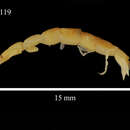en
names in breadcrumbs


“Paranthura possessia sp. nov.
Description
Female
Integument moderately indurate, uropods and telson strongly indurate. Body proportion : C G 1 < 2 = 3 < 4 > 5 > 6 > 7. Cephalon with anterolateral corners extending beyond triangular rostrum. Eyes well pigmented, dorsolateral. Pleonites separate ; pleonite 6 longest, with middorsal slit in posterior margin. Telson lanceolate, apex narrowly rounded, dorsally gently convex.
Antennule with 4-segmented peduncle, first segment longest and broadest, segment 4 short; flagellum of six articles. Antenna with 5-segmented peduncle, segment 2 grooved to accommodate antennule; flagellum of three articles, two distal articles very short. Mandibular palp 3-segmented, first and third segments subequal in length, second segment twice length and broader, third segment with row of ten to twelve spines. Maxilla slender, lancet-like, with distal barbs. Maxilliped 2-segmented, terminal segment bearing several setae distally and on medial margin. Pereopod 1 subchelate, propodus proximally broad, palm with convex ridge on inner face bearing irregular double row of setae; outer face slightly concave, with single row of setae and proximal rounded process ; carpus triangular, with several setae distally. Pereopods 2 and 3 similar, subchelate, more slender and elongate than pereopod 1; propodal palm with eight sensory spines. Pereopods 4-7 similar; propodus elongate/rectangular with four sensory spines on posterior margin; carpus with anterior and posterior margins subequal in length; posterior margin with four sensory spines. Pleopod 1 exopod operculiform; endopod narrow, slightly shorter than exopod; basis with two retinaculae. Uropodal exopod with outer margin slightly sinuous, apex rounded; endopod slightly longer than wide, rounded, reaching to telsonic apex.
Male
Eyes slightly larger than in female. Antennules elongate, with whorls of filiform aesthetascs. Pleopod 2 with copulatory stylet on endopod extending well beyond ramus, distally narrowed and recurved, apex rounded; distal half bearing very fine spinules.
Material
Holotype PM. Is. 1014, 1 ovig. female TL 14,0 mm.
Paratype PM. Is. 1015, 1 ovig. female TL 14,0 mm 4 female TL 13,5 14,2 14,2 15,6 mm.
Paratypes USNM 173119, 1 male TL 13,9 mm 1 ovig. female TL 15,6 mm. 2 female TL 14,1 15,6 mm
Paratypes SAM—A16771, 1 ovig. female TL 15,0 mm 1 female TL 15,5 mm. 46/CP. 204 between Ile de la Possession and Ile aux Cochons, 375-490 m.
Additional material : 2 female 2 juv. 78/CP.319, 1 female 75/CP.303, 1 female 9/CP.74, 1 female 68/CP.273
Remarks
The present material to some extent resembles two species described by Kussakin (1967). P. argentinae, however, has a broader telson, a narrow and non-sinuous uropodal exopod, and the proportions of the three mandibular palpal segments also differ. P. antarctica differs from P. possessia in having fewer antennular flagellar articles, a non-sinuous uropodal exopod, and in the relative proportions of the antennal peduncle segments.
P. neglecta Beddard, (1886) was described from Kerguelen Island, but not figured. Examination of the type has shown it to be a juvenile, with pereonite 7 very short and lacking legs. The telson of this specimen is much more broadly oval than the present species, while the uropodal exopod is very obviously notched.
Etymology
The specific name derives from the type locality, Ile de la Possession.”
(Kensley, 1980: 168-171)